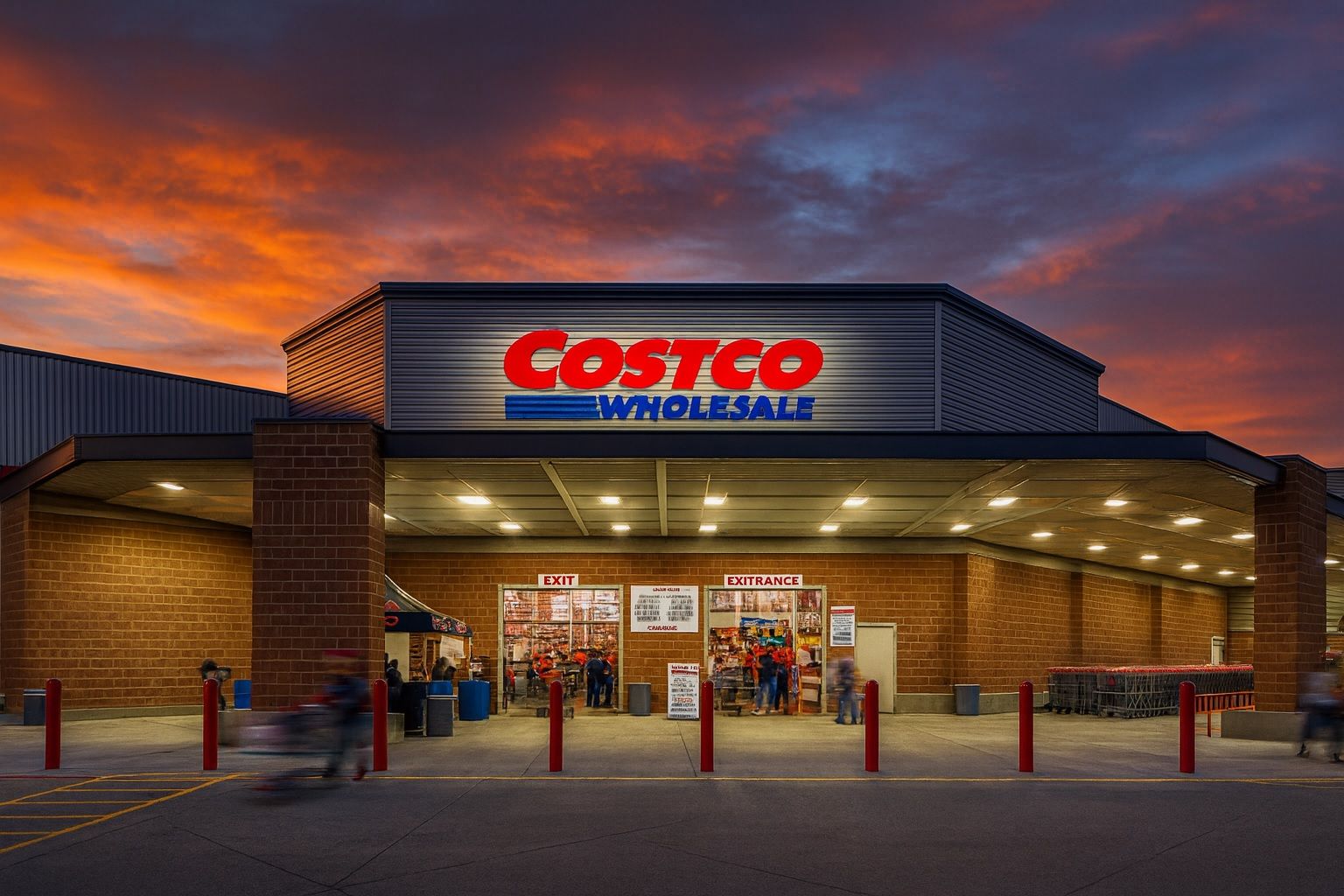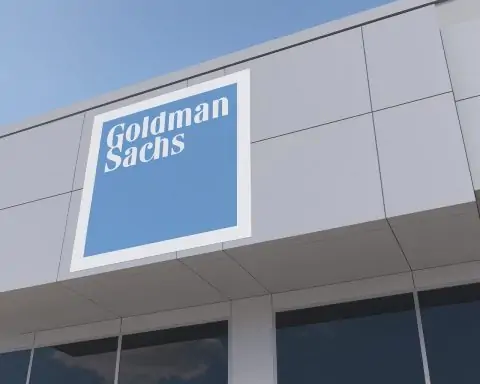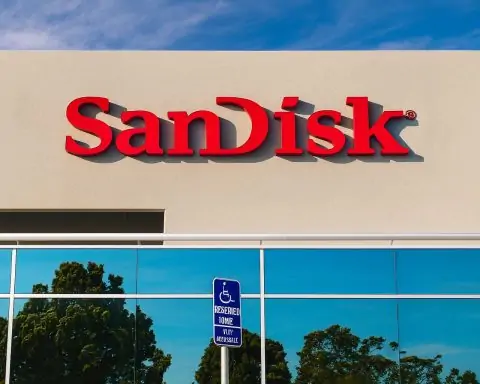- Current Price & Recent Moves: Costco Wholesale’s stock (NASDAQ: COST) trades around $915 per share as of October 9, 2025 [1]. Shares are roughly flat year-to-date after a rollercoaster 2025 – they hit an all-time high near $1,078 earlier in the year before pulling back about 15% to the mid-$900s [2]. In the past week the stock has ticked up on strong sales news and sits slightly above its level a month ago [3], showcasing resilience in a volatile market.
- Strong Earnings Amid Cautious Consumers: Costco delivered better-than-expected fiscal Q4 2025 results, with revenue and earnings topping analyst forecasts [4]. Net sales for the summer quarter were about $84.4 billion (up ~8% year-over-year) and net income jumped 11% to $2.61 billion [5]. Comparable store sales grew a solid +5.7% (including a +13.6% surge in e-commerce) [6]. Despite the strong quarter, Costco’s stock initially dipped ~3% after the late-September earnings report as U.S. same-store sales came in slightly below some expectations [7]. Executives noted slight consumer pullback in discretionary items (e.g. electronics, jewelry) and rising cost pressures, which tempered otherwise robust results [8].
- September Sales Boost: Costco’s momentum continued into the fall. September net sales hit $26.58 billion, up ~8.0% from a year earlier [9]. This strong monthly report – with comp sales up around 5–6% – eased Wall Street’s worries about any post-summer slowdown [10]. The upbeat numbers (helped by growth in both store and online sales) sparked a rally in COST shares, which jumped back into the $920s in early trading on Oct. 9 [11].
- Competitive Edge in a Tough Retail Climate: Costco is bucking the broader retail slump. Many retailers saw sluggish sales and falling traffic this summer amid inflation, but Costco “bucked the retail slowdown” with its value-focused model [12] [13]. In fact, while Target and Walmart recently reported year-over-year drops in store visits, membership-based warehouse clubs (Costco, Sam’s Club, BJ’s) have seen foot traffic rise +3% to +6% – a sign consumers are flocking to bulk-value retailers [14]. Analysts note Costco’s loyal members and low prices give it a “much wider moat” than traditional rivals [15]. As retail expert Burt Flickinger bluntly put it, Costco is “better at everything” – from pricing power to customer satisfaction – versus many competitors [16].
- Strategic Moves & Member Value: Costco continues to find creative ways to drive growth and member enthusiasm. Recently it began selling one-ounce gold bars online, priced around $1,900 each – and they’ve been selling out within hours of restocking amid record gold prices above $4,000/oz [17]. Analysts estimate Costco is moving over $200 million of gold and silver per month through these deals [18]. While a tiny slice of revenue, the gold-bar buzz showcases Costco’s ability to create “treasure hunt” excitement and boost e-commerce engagement. The retailer has also expanded member services, launching partnerships for low-cost telehealth visitsand even home improvement services [19]. These perks add value to Costco’s membership program (with renewal rates ~90% [20]) and reinforce the chain’s strategy of increasing customer loyalty.
- Analyst Sentiment & Valuation: Wall Street remains broadly bullish on Costco. ~30 analysts collectively rate the stock a “Buy” (on average), and the 12-month median price target is about $1,065 – roughly 15% above the current share price [21]. No major firm recommends selling at this point: it’s mainly a debate between Buy and Hold, reflecting Costco’s stellar business versus its rich valuation [22]. Indeed, Costco trades around 50× trailing earnings and ~30× forward earnings, a premium well above retail peers (for perspective, Walmart’s forward P/E is ~34× and Target’s is ~11×) [23] [24]. Bulls argue the high multiple is justified by Costco’s consistent growth and defensive “sleep-well-at-night” business model [25] [26]. Skeptics, however, warn that the stock is “priced for perfection” – any stumble or consumer slowdown could spur a sharp pullback from these elevated levels [27] [28].
- Stock Performance & Outlook: Even after its huge run-up in recent years, Costco’s stock is vastly outperforming most retail peers. It’s around breakeven year-to-date (including dividends), versus double-digit declines in the broader retail stock index [29]. Looking ahead, experts say the holiday season will be pivotal. A strong Q4 (Costco’s FY2026 Q1) could propel the stock to new highs above $1,000, while any disappointment (e.g. weak December sales or a cautious outlook) might cause a pullback to the $850–$900 range [30]. Over the next 1–2 years, if Costco can sustain high-single-digit earnings growth, some forecasts put the stock around $1,100–$1,200 (mid-teens % upside) by 2027 [31]. Longer-term, Costco is viewed as a steady compounder – its expanding global footprint and loyal member base should continue driving ~8–10% annual EPS growth. As one Forbes analysis put it: Costco is a “great business” that will likely keep compounding earnings for years to come, making it a solid stock to simply own for the long haul [32] [33].
Stock Price & Recent Performance
Costco’s stock has been on a long-term upward climb, and 2025 is no exception – though it hasn’t been a smooth ride. After a strong rally in the first half of the year, Costco (COST) shares reached an intraday record high around $1,078earlier in 2025 [34]. Enthusiasm was fueled by robust sales growth and a broader market rally. However, by late summer the stock had pulled back into the mid-$900s amid some profit-taking and market volatility [35]. As of October 9, 2025, COST trades in the $914–$928 range [36] – essentially back to where it started the year (roughly flat year-to-date when including dividends) [37].
Notably, this flat YTD performance masks significant resilience relative to other retailers. Over the past month Costco stock did dip ~3–4% following earnings, but it has since rebounded on sales news [38]. In the past week alone, shares are up modestly (+1–2%) [39]. Crucially, Costco has held its value far better than peers in 2025: for context, the S&P 500 Retail ETF is down double-digits this year, and even industry giant Walmart’s stock has slipped in recent weeks, whereas Costco remains near breakeven [40]. In short, Costco’s stock is only a few percentage points below its all-time highs, vastly outperforming many retail peers over the last year [41]. This relative strength underscores investors’ confidence in Costco’s model, even as the retail sector broadly faces challenges.
However, Costco’s high stock price also means higher volatility on news. With shares “priced for perfection,” we’ve seen the stock gyrate on even minor updates [42]. Traders should be prepared for continued short-term swings – but so far, Costco’s fundamental momentum has underpinned a strong overall trajectory despite the choppiness.
Recent Earnings and Sales Highlights
The latest earnings confirmed that Costco’s business momentum remains solid. On September 25, Costco reported its fiscal Q4 2025 results (for the quarter ending late August), and the numbers impressed. Quarterly revenue rose ~8% to $86.16 billion, slightly above analyst expectations [43]. Net sales were $84.4 billion for the quarter [44], indicating steady mid-single-digit growth even as many retailers struggled. Profit growth was even stronger: net income jumped ~11% to $2.61 billion (about $5.87 per share, topping the ~$5.81 consensus) [45]. In other words, Costco beat the Street’s forecasts on both the top and bottom line.
Operationally, Costco’s fourth quarter showed strength across key metrics. Comparable store sales increased +5.7%year-over-year [46] (excluding fuel and currency impacts), demonstrating healthy growth on top of last year’s gains. Importantly, e-commerce sales rebounded by +13.6% in Q4 [47] – a sharp improvement after a period of flat/negative online sales earlier in the year. Management credited better online merchandising and strong demand in categories like appliances and electronics for the digital sales surge [48]. Costco also saw store traffic increase ~4–5% during the quarter [49] [50], a very positive sign given many big-box chains saw customer visits stagnate or decline. The only soft spots were in discretionary merchandise: like many retailers, Costco noted that consumers have become more cautious on non-essentials (e.g. fewer big-ticket electronics and jewelry purchases) [51]. Still, those were more than offset by gains in staple categories (food, household goods) and growing membership revenue.
Despite the overall beat, Costco’s stock initially slipped ~2–3% after the earnings release, as some investors focused on a couple of lukewarm datapoints. In particular, U.S. same-store sales came in a bit below forecasts (in the low-to-mid single digits, versus higher expectations) [52]. Additionally, Costco’s executives struck a cautiously optimistic tone – acknowledging slight pullback in high-price discretionary items and ongoing cost pressures (from wages, supply chain, etc.) [53] [54]. This cautious commentary and the modest comps miss prompted short-term traders to take profits. On the day after earnings, Costco was among the weaker performers in the S&P 500, falling from around $940 to the low $900s [55].
Crucially, that post-earnings dip proved short-lived. Within days, sentiment swung positive again thanks to stellar September sales results that Costco reported in early October. On October 8, the company released a brief update for the five-week retail month of September, and it was bullish: net sales of $26.58 billion, up ~8.0% year-over-year [56]. This marks an acceleration from the summer months and extends Costco’s streak of steady mid-to-high single-digit monthly sales growth. Within that figure, comparable sales for September were estimated around +5.7% overall (with U.S. up ~4.5%, International ~7%, and e-commerce roughly +11%) [57]. In other words, Costco’s growth showed no sign of cooling as fall began. Analysts noted that this strong showing helped reassure the market that Costco isn’t seeing a slowdown despite consumers’ inflation worries [58] [59]. MarketWatch even commented that Costco’s consistent sales gains are easing fears of future deceleration [60].
Investors clearly liked what they saw: Costco’s stock jumped on the September sales news, climbing in pre-market trading on Oct. 9 and helping erase the post-earnings weakness [61]. By Oct. 9, shares were trading back in the mid-$920s [62]. The strong September report suggests Costco entered the important fall season with excellent momentum. It also bodes well for the upcoming holiday quarter, as robust back-to-school and early fall sales often indicate a healthy consumer appetite.
Looking ahead, Costco will provide its next monthly sales update in early November (for October results) and is due to report fiscal Q1 2026 earnings in December [63]. Those will be closely watched for clues on holiday trends and whether Costco can maintain its growth pace. Notably, Costco has not raised its membership fees since 2017, and many analysts believe a fee hike could be on the horizon in late 2025 or 2026 – which would provide a one-time earnings boost when implemented [64]. Management has been mum on timing, but any hints in upcoming reports about a potential fee increase will be a focal point for investors (historically, Costco tends to hike membership rates roughly every 5-6 years). In the meantime, the latest results show Costco excelling even in a challenging retail environment, which is underpinning its strong stock performance.
Recent News and Strategic Initiatives
Beyond the raw financials, Costco has generated a lot of positive buzz with some recent initiatives that highlight its unique approach to retail. One headline-grabbing development: Costco began selling 1-ounce gold bars on its website in September – and they’ve effectively become an overnight sensation [65]. Priced at roughly $1,900 each, these gold bars have been selling out within hours whenever they’re restocked [66]. This craze coincided with gold prices hitting record highs (above $4,000 per ounce in early October) and reflects how Costco can capitalize on timely trends. According to analysts, Costco’s sales of gold and silver bullion are now estimated at over $200 million per month [67]. While that’s still a tiny fraction of Costco’s overall revenue, it’s a highly intriguing new line of business. More importantly, it’s a savvy way to drive e-commerce growth – these gold bars are available online-only to members, so they’re bringing shoppers onto Costco’s digital platform. As one retail analyst quipped, Costco found a “gateway” product that attracts customers and underscores its reputation for bargains even in unexpected categories (after all, a $1,900 gold bar being sold at Costco is the ultimate treasure-hunt item).
Costco is also doubling down on member services and perks as part of its growth strategy. In recent months, the company rolled out new healthcare offerings for its members – including a partnership to provide low-cost telehealth (virtual primary care) visits and expanded hearing/optical services. These moves aim to increase the value of a Costco membership beyond just merchandise. The idea is that if members can get affordable doctor consultations, or even home improvement services, through Costco, they have even more reasons to renew and stay loyal [68]. It’s a page from Costco’s long-term playbook: continually pack more value into the membership to make it indispensable for customers. This comes on top of other beloved perks, like cheap gas, discounted travel bookings, and the iconic in-store food court (where Costco infamously still sells a hot dog + soda combo for $1.50). All these factors contribute to Costco’s industry-leading ~90% membership renewal rate and growing member base [69] [70].
On the expansion front, Costco isn’t slowing down either. The company opened 10 new warehouses in the latest quarter and plans roughly 30 new locations in fiscal 2026 [71]. Notably, Costco continues to push into international markets – it now operates seven stores in China (after entering China in 2019 to huge crowds) and sees significant long-term opportunity overseas [72] [73]. International segments have been growing slightly faster than the U.S., aided by strong demand and favorable exchange rates in 2025 [74]. Each new warehouse can add hundreds of millions in annual sales, so this steady expansion provides a reliable engine for growth.
Finally, it’s worth mentioning that Costco underwent a leadership transition recently, albeit a very smooth one. On January 1, 2024, longtime CEO Craig Jelinek (who led Costco for 11 years) stepped down, and Ron Vachris took the helm [75]. Vachris is a 40-year Costco veteran who literally started as a forklift driver in the 1980s and worked his way up [76]. His appointment was part of a well-planned succession and signaled continuity – essentially a vote for “more of the same” successful strategy. Around the same time, Costco’s highly respected CFO Richard Galanti retired after nearly four decades; he was succeeded by Gary Millerchip (former CFO of Kroger) in early 2024 [77]. Millerchip’s tenure began with a bang, as he helped orchestrate a $15 per share special dividend announced in Dec 2023 (more on that in a moment) [78]. Nine months into the new leadership era, there have been no major strategic shifts – which is exactly what investors were hoping for. Costco continues to focus relentlessly on low prices, operational efficiency, and member value under Vachris and Millerchip, maintaining the culture that made it a retail juggernaut.
Competitive Landscape and Retail Industry Factors
Costco’s recent success comes at a time when much of the retail industry is facing headwinds. High inflation, shifting consumer spending habits, and rising interest rates have created a tricky environment for retailers in 2025. Many chains – especially traditional big-box and department stores – have struggled with slowing sales and declining foot traffic as consumers become more budget-conscious. This context makes Costco’s performance stand out even more starkly.
One key advantage for Costco is its unique membership warehouse model, which appears to be resonating strongly with shoppers in the current climate. Customers pay an annual fee to shop at Costco ($60 for the basic membership), which incentivizes them to maximize the value of that membership. In practice, that means members often shift more of their spending to Costco to get their money’s worth – a dynamic that has kept Costco’s store traffic growing even as others falter [79] [80]. According to third-party foot traffic data, Costco saw visits increase ~5% in 2025, whereas visits to Target and Walmart stores were down mid-single-digits over the same period [81] [82]. In August 2025 alone, Costco’s traffic was up 5.2% year-on-year, while Walmart’s was down 0.6% and Target’s fell even more [83] [84]. This suggests Costco is capturing trips that might otherwise go to traditional supermarkets or competitors – essentially winning market share in key categories like groceries and household essentials.
The value proposition is a big driver behind this trend. With inflation still squeezing wallets, consumers are seeking bargains and buying in bulk to save. Costco, with its famously low markups (capped around 14% over cost) and bulk packaging, directly caters to that behavior. Shoppers know they can generally trust Costco for great per-unit pricing, especially on staples – which keeps them coming back. And Costco’s limited SKU (stock-keeping unit) model, focusing on a curated selection of high-quality items (many under its popular Kirkland Signature private label), means it can leverage massive scale on each product to cut costs further. This has created a virtuous cycle: more members lead to more scale, which leads to lower costs/prices, which attracts more members.
Costco vs. Competitors: “A Much Wider Moat”
Analysts often describe Costco as having a “wider moat” than just about any other brick-and-mortar retailer [85]. Retail consultant Burt Flickinger III has stated that Costco enjoys durable advantages in pricing power, customer loyalty, and efficiency, making it extremely hard for rivals to compete [86]. Unlike Walmart or Target, which must battle e-commerce players on price and convenience, Costco’s warehouse club format offers a different experience altogether – almost a treasure hunt, where customers might come in for bulk toilet paper and leave with a kayak or a 72-ounce tomahawk steak. This creates a sense of excitement and loyalty that traditional retailers struggle to replicate. As Flickinger bluntly put it, Costco is “better at everything” compared to peers – an obvious exaggeration, but indicative of Costco’s strong reputation [87].
Even other wholesale clubs have a hard time matching Costco’s scale and cult following. Walmart’s Sam’s Club and BJ’s Wholesale are growing as well (the entire warehouse club segment is benefitting from consumer trade-down), but Costco remains the leader by sales and member count. All three big club chains have seen increases in customer visits (up 3–6% YoY), whereas most conventional retailers are flat or negative on traffic [88]. Costco’s membership base, now over 81 million paid households globally [89], is larger than Sam’s Club’s (~47 million members) and far more affluent on average – which gives Costco an edge in both spending power and pricing flexibility.
Another competitive differentiator: membership fee income. Costco generates billions of dollars from membership dues (about $4.5 billion in the past year) [90], which is almost pure profit. These fees essentially cover a large portion of Costco’s operating profit, allowing the company to price its merchandise ultra-thin and still make money. It’s a model that competitors without membership income (like Walmart/Target) simply can’t mirror easily. In the latest quarter, Costco’s membership fee revenue rose ~13% to $1.72 billion [91] [92], buoyed by new member sign-ups and a fee increase in its International markets. Renewal rates remain around 90% – indicating extremely high satisfaction and stickiness [93]. Additionally, Costco’s strategy of continually adding new membership perks (from travel booking to car rentals to the newer health services) builds an ecosystem that rivals have a hard time penetrating.
From a financial perspective, Costco’s consistency also sets it apart in the retail landscape. During fiscal 2025, Costco’s total revenue grew ~8%, significantly outpacing many peers – for example, Walmart’s revenue was up around 6–7% for a comparable period, and Target’s sales were roughly flat or even slightly down [94]. That means Costco is grabbing market share in key categories. Its profit margins, while thin (around 3% net margin [95]), held steady or improved slightly this year despite cost inflation – thanks to cost controls and scale efficiencies. In an era where retailers like Target have seen margins shrink due to higher labor, theft (shrink), and discounting pressures, Costco managed to maintain stable margins by running a tight ship and leveraging its no-frills, high-volume model [96]. Moreover, some macro factors actually play to Costco’s favor: for instance, in a high-interest rate environment, Costco earns more interest income on its huge cash reserves (over $12 billion on hand) [97], providing a small boost to earnings even as other companies struggle with higher borrowing costs.
To be sure, Costco is not immune to all industry challenges. It faces some of the same headwinds as others – for example, rising wages (Costco has proactively raised starting pay to ~$17–18/hour to stay ahead of competitors) and global supply chain uncertainties. There’s also the broader threat of e-commerce: while Costco’s brick-and-mortar business is thriving, the shift to online shopping is an ongoing competitive battle (Amazon, for instance, competes in many of the same categories). However, Costco has arguably found a sweet spot that’s “Amazon-proof” to a degree – bulk purchases of groceries and sundries are less convenient to get delivered, and Costco’s treasure-hunt shopping trip is something Amazon can’t replicate. Additionally, Costco’s move to boost its online capabilities (as seen with the gold bar sales and a 15.6% jump in digital sales for FY2025 [98] [99]) shows it’s adapting to the new era while playing to its strengths.
In summary, macro conditions like inflation and a value-seeking consumer base have actually played into Costco’s hands. The company’s relentless focus on low prices, limited but high-quality selection, and member-centric perks has made it a retail winner even as others stumble. As consumers “trade down” from luxury stores or even from regular supermarkets, Costco is picking up those sales. This favorable positioning helps explain why Costco’s stock has been so resilient and why investors are willing to accord it a premium valuation relative to retail peers.
Analyst Views, Valuation, and Forecasts
Wall Street’s overall stance on Costco can be summed up as: stellar company, somewhat expensive stock, but still a long-term winner. The consensus among analysts is overwhelmingly positive on the business itself – virtually no one disputes Costco’s strengths. Out of roughly 30 analysts covering the stock, 19 rate it a Buy and 11 rate it Hold, with 0 Sells on the books [100]. This unanimity that Costco is not a “sell” reflects its reliable track record. The main debate is simply whether investors should buy at the current high price or wait for dips.
The average 12-month price target is about $1,065 per share [101], implying a ~15% upside from the ~$920 level. However, there’s a pretty wide range of opinions on valuation. On the bullish end, some analysts see a lot more upside: for instance, Goldman Sachs recently raised its target to $1,418 (reiterating a Buy) [102] – a wildly high call that assumes Costco’s premium valuation will persist or even expand. Another bullish research firm, Argus, put a $1,200 target on COST after the earnings beat, arguing Costco’s defensive growth merits a continued premium [103] [104]. These optimistic forecasts bank on Costco’s ability to keep growing earnings in almost any economic environment (Costco is often called a “core holding” – a stock to own indefinitely – by bulls).
On the cautious side, some analysts are urging moderation purely due to valuation. Citigroup, for example, has a Neutral rating and a $990 price target [105], basically saying the stock is fairly valued around current levels. Similarly, Mizuho’s analyst team maintained a Neutral stance (Hold) with a target in the high-$900s, noting that “the share price already reflects a lot of optimism” [106]. They point out that at 30–40× earnings, Costco leaves little margin for error – any slowdown in growth could cause the P/E multiple to compress. In Mizuho’s view, Costco is a fantastic company but not a screaming buy when it’s hovering near $900+. This sentiment – great business, rich stock price – is echoed by several others who have Hold ratings despite admiring Costco’s fundamentals.
Indeed, Costco’s valuation metrics are well above retail industry norms. At ~50× trailing earnings and around 45× forward earnings, Costco’s P/E ratio is more akin to a high-growth tech company than a retailer [107]. Its EV/EBITDA is ~25× and Price/Sales about 1.5×, whereas a behemoth like Walmart trades at ~0.8× sales [108]. By almost any yardstick, Costco’s stock is “expensive” relative to its current earnings and growth rate [109] [110]. However, there are clear reasons investors are willing to pay this premium:
- Exceptional Consistency and “Defensive” Growth: Costco offers a rare combination of steady, recession-resistant growth. It’s often seen as a “sleep-well-at-night” stock – Costco tends to thrive even in downturns as consumers flock to its bargains [111]. During the 2008 recession and 2020 pandemic, Costco’s sales actually grew while many retailers faltered [112]. This reliability is scarce, and the market rewards it with a higher multiple. Some bulls even view Costco almost like a consumer-staples or utility stock (stable demand), but with more growth – a hybrid that can justify a P/E in the 30s or 40s, they argue [113].
- Long Runway for Expansion: Costco still has less than 900 warehouses globally, and management sees room for hundreds more in the coming decades [114] [115]. New stores, especially internationally, provide a built-in path for steady growth. As long as Costco keeps executing, it can expand its footprint for years. This gives growth-oriented investors confidence that earnings can continue rising ~10% annually, supporting a higher valuation.
- Member Loyalty and Pricing Power: With renewal rates around 90% and a growing base of younger members, Costco’s membership model is only getting stronger [116] [117]. The ability to raise fees (eventually) or drive more spend per member is a lever for future profit that isn’t fully tapped. For instance, if Costco implements a membership fee hike in the next year or so (a plausible scenario), it could add an extra 5–10% to EPS growth in that year [118]. Bulls note that such levers – along with Costco’s pristine balance sheet which could allow buybacks or special dividends – aren’t fully reflected in current earnings, meaning Costco might be a bit underearning relative to its potential.
On the flip side, bearish arguments (few but vocal) focus primarily on what happens if Costco ever stumbles or if economic factors change the market’s appetite for high valuations. If, say, sales growth slowed to a crawl or a recession hit discretionary spending, Costco’s earnings might grow only low-single-digits for a time. In that case, the market might decide Costco should trade at a more “normal” multiple (e.g. 20–25× earnings, closer to other retailers). A severe valuation reset from ~40× to ~25× could theoretically cut Costco’s stock nearly in half – a dramatic scenario, but one bears mention to illustrate the risk of a lofty valuation [119] [120]. Most analysts don’t foresee anything that drastic near-term, but it underscores that high valuation = high expectations. Additionally, the broader market environment cannot be ignored: with the 10-year Treasury yield hovering around 4.5–5% in late 2025, some investors may prefer a “risk-free” 5% return to paying 50× earnings for Costco’s stock [121]. Rising bond yields tend to pressure high-P/E stocks like Costco, as the cost of capital increases and equities face competition from bonds for investor dollars [122]. This has been a factor in recent market volatility. However, it’s worth noting that Costco’s finance chief has pointed out a small silver lining – higher rates also mean Costco earns more interest on its cash hoard, providing a minor earnings tailwind [123] [124]. Still, the net effect of rising rates is usually a headwind for stock valuations.
Near-Term Catalysts and Forecasts
In the short term (next 3–6 months), Costco’s stock will likely take its cues from a few key factors: holiday season performance, monthly sales trends, and macro news. The holiday quarter is crucial for all retailers, and Costco’s fiscal Q1 (Sep-Nov) includes the core of that season. If Costco reports a strong Thanksgiving/Christmas period – say, mid-high single digit comps and continued traffic growth – it could be the catalyst for COST shares to break into four digits (>$1,000) for the first time [125]. Positive commentary from management about early 2026 trends or membership growth could likewise fuel optimism. Conversely, if holiday sales disappoint or Costco issues cautious guidance (e.g. noting softening consumer demand), the stock might pull back into the $850–$900 range [126], where value-focused investors could see it as a buying opportunity. Broader market swings will also play a role; however, notably, Costco often holds up better than the market during sell-offs due to its defensive characteristics (investors tend to hide in Costco given its stable business) [127]. So even if we see general market turbulence, Costco may prove relatively resilient.
In the medium term (1–2 years), the trajectory of Costco’s stock will likely mirror its earnings growth with some influence from valuation multiples. Analysts modeling out the next couple of years generally assume Costco can continue to grow earnings at a high-single-digit to ~10% annual rate (driven by new store openings, modest comp sales increases, and possibly a membership fee hike in the period) [128]. If that happens, and if the market only gently eases Costco’s P/E down (say from ~40× to ~35× over two years), the stock would drift upward accordingly – potentially reaching the ~$1,100–$1,200 range by late 2027 [129]. That would represent a decent total return when combined with dividends. On the other hand, if there’s a sharper valuation contraction to, say, 25–30× earnings, Costco’s stock could stagnate or even decline despite growth [130]. Most analysts view that scenario as lower probability unless something fundamentally changes (for example, a notable hit to Costco’s sales momentum or membership loyalty, which currently is not expected).
Zooming out to the long term (5+ years), Costco’s investment thesis hinges on steady compounding. With its continued global expansion, extremely loyal customer base, and a business model that has thrived across economic cycles, Costco is positioned to keep delivering solid growth. Even if revenue growth averages, hypothetically, 5–7% annually and EPS growth 8–10% (assuming a bit of margin improvement or buybacks), that would translate into substantial shareholder returns over a decade when combined with some modest multiple support. Many pension funds and long-term holders keep Costco in their portfolios for this reason – it’s not likely to double overnight, but it has a high probability of being larger (and more profitable) in 5, 10, 15 years. As one Forbes contributor famously summarized: Costco is a “great business” that will likely continue compounding earnings year after year, so even if the stock looks pricey at times, it’s “rarely a bad idea to simply own it for the long haul” [131]. That long-term confidence underpins why Costco often trades at a premium: investors are willing to pay up for quality and dependability.
Dividends and Shareholder Returns
While Costco is not primarily a dividend stock, it does provide shareholder returns both through regular payouts and occasional windfalls. The current quarterly dividend is $1.30 per share, which was hiked significantly from $0.90 in 2024 [132] [133]. That annualizes to $5.20 per share, giving a dividend yield of only about 0.55–0.60% at the current stock price [134]. This yield is relatively low (Costco’s share price appreciation has outpaced dividend growth), and is below what you’d get from many other retailers or the 10-year Treasury. However, Costco’s payout ratio is just ~28% of earnings [135], meaning the company retains plenty of profits for reinvestment. The dividend has grown at roughly a 13% compound annual rate over the past five years [136], reflecting Costco’s rising earnings.
The real kicker is Costco’s history of special dividends. Unlike most companies, every few years Costco rewards shareholders with a one-time large dividend when it finds itself with excess cash. In December 2020, for example, it paid a $10 per share special dividend [137], and then in January 2024 (announced late 2023) it paid an even bigger $15 per share special dividend [138]. These payouts – which amounted to $4.4 billion in 2020 and about $6.7 billion in 2024 – are on top of the regular dividends. Over the past 11 years, Costco has paid five special dividends [139], a remarkable record that substantially boosts long-term shareholder returns. For instance, that $15 special dividend was equivalent to an extra ~1.6% yield at the time [140]. Costco’s willingness to share excess cash with investors in this manner is seen as a sign of financial strength and disciplined capital management. It’s also a nice perk for patient shareholders – you might not get a high yield annually, but every so often you get a hefty check when business is booming and cash accumulates.
Looking ahead, Costco’s capital return approach will likely remain consistent: moderate regular dividend raises and occasional specials if cash really piles up. The company does not do large share buyback programs (preferring these cash dividends instead), and it maintains a very strong balance sheet with minimal debt. This conservative financial approach, combined with the robust sales and earnings growth, puts Costco in a very secure position to keep rewarding shareholders over time – even if the main attraction for investors is the stock’s price appreciation rather than yield.
Bottom Line: Costco Wholesale has managed to shine in a challenging retail landscape. The stock, now around $915, has weathered 2025’s market swings and is hovering near record highs, supported by Costco’s reliable growth and loyal customer base. Recent news has been mostly positive – earnings are up, sales keep climbing, and Costco is innovating (whether through new services or attention-grabbing products like gold bars) to strengthen its moat. While the stock isn’t cheap by any means, Wall Street largely agrees that Costco’s quality merits a premium. In the near term, keep an eye on the holiday season and any hints of a membership fee increase, as these could be catalysts. Longer term, Costco looks poised to continue its steady expansion and profit growth. For investors, that means that short-term volatility aside, Costco remains one of the most solid franchise stocks in retail – a company that has proven it can deliver value to shoppers and shareholders alike, in good times and bad [141].
Sources: Costco investor releases and financial reports; ts2.tech analysis and market commentary [142] [143]; expert insights from Bloomberg, MarketBeat, and Investopedia [144] [145]; industry data from Placer.ai and others on retail traffic [146]; Business Insider on Costco’s gold bar sales [147]; and Wall Street analyst forecasts via MarketBeat and Yahoo Finance [148] [149]. All information is up-to-date as of October 9, 2025.
References
1. ts2.tech, 2. ts2.tech, 3. ts2.tech, 4. ts2.tech, 5. ts2.tech, 6. ts2.tech, 7. ts2.tech, 8. ts2.tech, 9. ts2.tech, 10. ts2.tech, 11. ts2.tech, 12. ts2.tech, 13. ts2.tech, 14. ts2.tech, 15. ts2.tech, 16. ts2.tech, 17. ts2.tech, 18. ts2.tech, 19. ts2.tech, 20. ts2.tech, 21. ts2.tech, 22. ts2.tech, 23. ts2.tech, 24. ts2.tech, 25. ts2.tech, 26. ts2.tech, 27. ts2.tech, 28. ts2.tech, 29. ts2.tech, 30. ts2.tech, 31. ts2.tech, 32. ts2.tech, 33. ts2.tech, 34. ts2.tech, 35. ts2.tech, 36. ts2.tech, 37. ts2.tech, 38. ts2.tech, 39. ts2.tech, 40. ts2.tech, 41. ts2.tech, 42. ts2.tech, 43. ts2.tech, 44. ts2.tech, 45. ts2.tech, 46. ts2.tech, 47. ts2.tech, 48. ts2.tech, 49. ts2.tech, 50. ts2.tech, 51. ts2.tech, 52. ts2.tech, 53. ts2.tech, 54. ts2.tech, 55. ts2.tech, 56. ts2.tech, 57. ts2.tech, 58. ts2.tech, 59. ts2.tech, 60. ts2.tech, 61. ts2.tech, 62. ts2.tech, 63. ts2.tech, 64. ts2.tech, 65. ts2.tech, 66. ts2.tech, 67. ts2.tech, 68. ts2.tech, 69. ts2.tech, 70. ts2.tech, 71. ts2.tech, 72. ts2.tech, 73. ts2.tech, 74. ts2.tech, 75. ts2.tech, 76. ts2.tech, 77. ts2.tech, 78. ts2.tech, 79. ts2.tech, 80. ts2.tech, 81. ts2.tech, 82. ts2.tech, 83. ts2.tech, 84. ts2.tech, 85. ts2.tech, 86. ts2.tech, 87. ts2.tech, 88. ts2.tech, 89. ts2.tech, 90. ts2.tech, 91. ts2.tech, 92. ts2.tech, 93. ts2.tech, 94. ts2.tech, 95. ts2.tech, 96. ts2.tech, 97. ts2.tech, 98. www.businessinsider.com, 99. www.businessinsider.com, 100. ts2.tech, 101. ts2.tech, 102. ts2.tech, 103. ts2.tech, 104. ts2.tech, 105. ts2.tech, 106. ts2.tech, 107. ts2.tech, 108. ts2.tech, 109. ts2.tech, 110. ts2.tech, 111. ts2.tech, 112. ts2.tech, 113. ts2.tech, 114. ts2.tech, 115. ts2.tech, 116. ts2.tech, 117. ts2.tech, 118. ts2.tech, 119. ts2.tech, 120. ts2.tech, 121. ts2.tech, 122. ts2.tech, 123. ts2.tech, 124. ts2.tech, 125. ts2.tech, 126. ts2.tech, 127. ts2.tech, 128. ts2.tech, 129. ts2.tech, 130. ts2.tech, 131. ts2.tech, 132. ts2.tech, 133. ts2.tech, 134. ts2.tech, 135. ts2.tech, 136. ts2.tech, 137. ts2.tech, 138. ts2.tech, 139. ts2.tech, 140. ts2.tech, 141. ts2.tech, 142. ts2.tech, 143. ts2.tech, 144. ts2.tech, 145. ts2.tech, 146. ts2.tech, 147. ts2.tech, 148. ts2.tech, 149. ts2.tech







